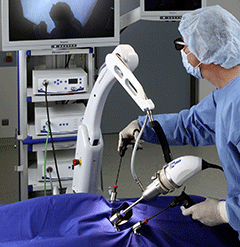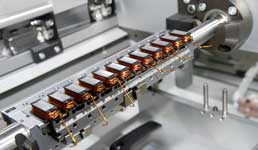3D technology was introduced into the medical endoscopy
- Details
- Hits: 14910
 Patient-friendly, minimally invasive interventions, for example in laparoscopy (laparoscopy), are unthinkable without high-resolution imaging methods. Two-dimensional, area-wide insights into the body have been established in endoscopy for years. Three-dimensional images, as known from the cinema, were not available to the surgeon for a long time. The new laparoscopy system "Einstein Vision" from Schölly Fiberoptic, together with the high-precision drive technology from PI (Physik Instrumente) Micos integrated in the handle, ensures a more atraumatic operating room world.
Patient-friendly, minimally invasive interventions, for example in laparoscopy (laparoscopy), are unthinkable without high-resolution imaging methods. Two-dimensional, area-wide insights into the body have been established in endoscopy for years. Three-dimensional images, as known from the cinema, were not available to the surgeon for a long time. The new laparoscopy system "Einstein Vision" from Schölly Fiberoptic, together with the high-precision drive technology from PI (Physik Instrumente) Micos integrated in the handle, ensures a more atraumatic operating room world.
 For several years, a major change in endoscopy is recognizable: the 3D technology was introduced, helping to optimize laparoscopic surgeries. The vivid, detailed images that match a natural three-dimensional vision, allow a better hand-eye coordination, prevent the surgeon from fatigue and facilitate the tissue preparation in the body. The modern, high-resolution 3-D laparoscopy consisting of highly brilliant finish, full HD camera and integrated in the handle driving techniques contributes significantly to make the course of the operation and the subsequent healing process for the patient, gentle and so few complications as possible .
For several years, a major change in endoscopy is recognizable: the 3D technology was introduced, helping to optimize laparoscopic surgeries. The vivid, detailed images that match a natural three-dimensional vision, allow a better hand-eye coordination, prevent the surgeon from fatigue and facilitate the tissue preparation in the body. The modern, high-resolution 3-D laparoscopy consisting of highly brilliant finish, full HD camera and integrated in the handle driving techniques contributes significantly to make the course of the operation and the subsequent healing process for the patient, gentle and so few complications as possible .
Schölly Fiberoptic GmbH, with headquarters in Denzlingen has in recent years added a focal points of development work on the area of 3D technology and has achieved remarkable results: the already field proven Laparoskopiesystem "Einstein vision" full HD-quality features in 3D that provides a true representation of the finest structures inside the body. Tissue can be separated so precise and exact positioning surgical needles. In principle, the new system is based on proven Laparoskopietechnik, has however, in contrast to conventional solutions 3D one camera head and a robotic arm that stabilizes the camera motion.
Principle of 3D Photography
 The principal function of the three-dimensional photography can be good with an analogy from nature to explain: In humans and many animals, the eyes are arranged so that they can view their surroundings at the same time from two different angles. The eyes, therefore, provide two divergent images. The brain puts them together into one image and "calculated" from the deviations of the spatial visual impression.
The principal function of the three-dimensional photography can be good with an analogy from nature to explain: In humans and many animals, the eyes are arranged so that they can view their surroundings at the same time from two different angles. The eyes, therefore, provide two divergent images. The brain puts them together into one image and "calculated" from the deviations of the spatial visual impression.
To produce spatial images 3D cameras use basically the same technique: two images simultaneously from different angles. Here, the lenses have to be in a defined distance, the so-called stereo base. In the human eye, for example, the distance is approximately 6,5 cm. The "double image" of the camera adds up to a three-dimensional image when the operator - like in the movies or watch TV - wearing appropriate glasses. Result of the process is a crisp, spatial recording of the internal body, which allows to operate safer and tissue sparing, such as the removal of tumors or lymph nodes in the pelvic floor reconstruction, etc.
 DC motor as an all-round talent for countless applications
DC motor as an all-round talent for countless applications
DC motor moves the lens
 The distance of the objects to be received of the lenses is variable. In order to still provide a clear account can, the camera was equipped with a zoom function. For this purpose, both lenses are synchronously moved linearly in line of sight. Driving force required for the generation of the image-3D simultaneous displacement of the two lenses in the camera head of the laparoscope is a DC drive. To the drive with the fixed lens holders coupled synchronous imaging at different distances is ensured. The surgeon must be placed just flip a switch on the camera head.
The distance of the objects to be received of the lenses is variable. In order to still provide a clear account can, the camera was equipped with a zoom function. For this purpose, both lenses are synchronously moved linearly in line of sight. Driving force required for the generation of the image-3D simultaneous displacement of the two lenses in the camera head of the laparoscope is a DC drive. To the drive with the fixed lens holders coupled synchronous imaging at different distances is ensured. The surgeon must be placed just flip a switch on the camera head.
The search for a suitable drive was not trivial. A set of application-specific requirements have to be fulfilled, such as the in the camera head available, limited installation space and the required low starting voltage of below 1 V. Despite this low voltage the comparatively heavy lenses have in each layer precisely and with a relatively large travel of 12,7 mm moved. In addition there were the high medical equipment requirements for reliability and durability.
Small, rugged drives with high power density
Well meet these application-specific requirements were due to a PI Micos designed for this application drive solution. The Karlsruhe to Physik Instrumente (PI) and owned and based in Eschbach near Freiburg company specializes in flexible positioning systems for the most diverse applications and was able to realize for the displacement of the two lenses of 3D laparoscope a customized solution.
Driving force is a small DC motor. The compact micro drive with a diameter of just 10 mm and a length of 42 mm including the gear impresses with its high power density. The low power consumption and a low start-up voltage of less than 1 V are further properties that predestine it for the application. The little power dwarf delivers an output of 0,1 W and can move the objects weighing almost 100 g bidirectionally without any problems.
 1 mm² image sensor enables the world's smallest digicam
1 mm² image sensor enables the world's smallest digicam
To the drive is linear to the movement direction. The rotary movement is a high-precision gear and tapped to a fine-thread spindle transfer, which then moves the slider to the holder for the two lenses. The plain between the slide and guide is thanks to a special low-friction coatings, and low backlash. The latter carries, like the high-torque starting of the DC motor to the fact that the lenses can be moved in spite of the low voltage is fast and precise. A direct response to the control signals is ensured.
The small coreless motor with ironless rotor coil and precious metal offers a low rotor inertia, and can be controlled thanks to its simple linear characteristic. This is done by the integrated control of the laparoscope in the motion controller. For limiting the travel range in the drive system of a small additional limit switch board is integrated. Despite the close relationships built in the camera head of the laparoscope is thus able to integrate a customized and reliable drive solution for the lenses. Of the so-realizable crisp, three-dimensional images from inside the body doctors and patients will benefit in the future more and more can.
